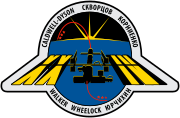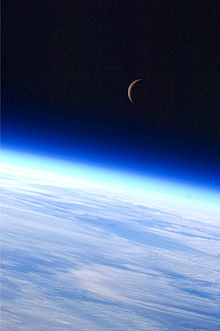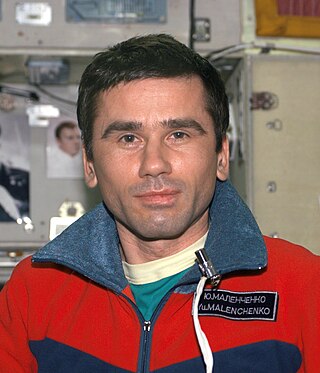
Yuri Ivanovich Malenchenko is a retired Russian cosmonaut. Malenchenko became the first person to marry in space, on 10 August 2003, when he married Ekaterina Dmitrieva, who was in Texas, while he was 240 miles (390 km) over New Zealand, on the International Space Station. As of December 2023, Malenchenko ranks third for career time in space due to his time on both Mir and the International Space Station (ISS). He is a former commander of the International Space Station.

Yury Valentinovich Lonchakov is a Russian former cosmonaut and a veteran of three space missions. He has spent 200 days in space and has conducted two spacewalks. From 2014 to 2017, Lonchakov served as head of the Yuri Gagarin Cosmonaut Training Center.
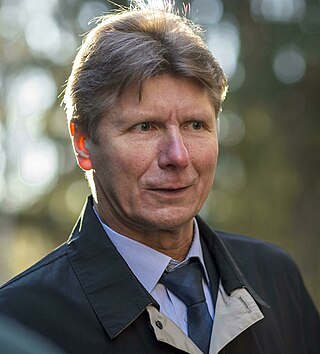
Gennady Ivanovich Padalka is a Russian Air Force officer and Roscosmos cosmonaut. Padalka held the world record for the most time spent in space at 878 days until Oleg Kononenko broke this record on February 4, 2024 at 07:30:08 UTC and is currently at 2nd position. He worked on both Mir and the International Space Station.

Fyodor Nikolayevich Yurchikhin is a Russian cosmonaut of Greek descent, engineer and RSC Energia test-pilot who has flown on five spaceflights. His first spaceflight was a 10-day Space Shuttle mission STS-112. His second was a long-duration stay aboard the International Space Station (ISS) as a flight engineer for Expedition 15; for this mission he was launched in the Soyuz TMA-10 spacecraft. He has undertaken two further long-duration stays aboard the ISS, as a crew member of Expedition 24 / 25. For this mission he was launched with the spacecraft Soyuz TMA-19, and he landed in November 2010, also with the Soyuz TMA-19 spacecraft. He served as Soyuz commander for his fourth mission aboard Soyuz TMA-09M, as flight engineer for Expedition 36 and ISS commander for Expedition 37. In April 2017, Yurchikhin launched on Soyuz MS-04 for the fifth spaceflight of his career, a six-month mission to the ISS as part of Expedition 51 and 52, for which he was the commander.

STS-131 was a NASA Space Shuttle mission to the International Space Station (ISS). Space ShuttleDiscovery launched on April 5, 2010, at 6:21 am from LC-39A, and landed at 9:08 am on April 20, 2010, on runway 33 at the Kennedy Space Center's Shuttle Landing Facility. The mission marked the longest flight for Space Shuttle Discovery.

Expedition 15 was the 15th expedition to the International Space Station (ISS). Four crew members participated in the expedition, although for most of the expedition's duration only three were on the station at any one time. During Expedition 15, the ISS Integrated Truss Structure was expanded twice: STS-117 brought the S3/S4 truss, and STS-118 brought the S5 truss.

Mikhail Borisovich Kornienko is a Russian cosmonaut who has undertaken multiple missions to the International Space Station (ISS).

Sergey Aleksandrovich Volkov is a retired Russian cosmonaut and engineer. He was a member of three missions to the International Space Station, spending more than a year in total in space. During his missions he did four spacewalks lasting more than 23 hours in total. Volkov retired from the Cosmonaut group in February 2017.
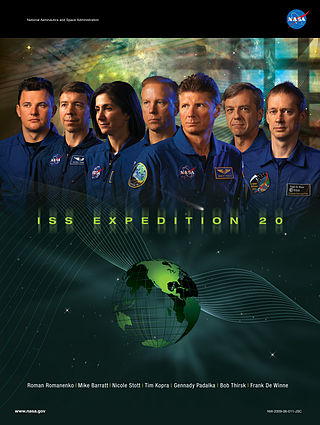
Expedition 20 was the 20th long-duration flight to the International Space Station. The expedition marked the first time a six-member crew inhabited the station. Because each Soyuz-TMA spacecraft could hold only three people, two separate launches were necessary: Soyuz TMA-14 launched on 26 March 2009, and Soyuz TMA-15 followed on 27 May 2009.
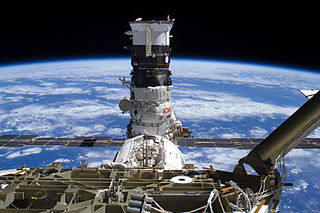
Poisk, also known as the Mini-Research Module 2, Малый исследовательский модуль 2, or МИМ 2, is a docking module of the International Space Station. Its original name was Docking Module 2, as it is almost identical to the Pirs Docking Compartment. Added in 2009, Poisk was the first major Russian addition to the International Space Station since 2001. Poisk is overall the same design as the docking module Pirs. Whereas Pirs was attached to the nadir ("bottom") port of Zvezda, Poisk is attached to the zenith ("top"); Pirs was closer to the Earth with the ISS in its usual orientation, and Poisk is on the other side. Poisk is Russian for explore or search. Poisk combines various docking, EVA, and science capabilities. It has two egress hatches for EVAs in addition to the two spacecraft docking ports. Although Poisk is designated as Mini-Research Module 2, it arrived before Mini-Research Module 1 (Rassvet), which had a different design; Poisk looks more like the Pirs docking port, which is not designated as a mini-research module.

Soyuz TMA-18 was a 2010 Soyuz flight to the International Space Station (ISS). TMA-18 was the 105th crewed flight of a Soyuz spacecraft since the first crewed flight in 1967.

Oleg Ivanovich Skripochka is a Russian engineer and cosmonaut. In 2011 he was in space serving as an Expedition 25/26 crewmember.

Expedition 23 was the 23rd long-duration mission to the International Space Station (ISS). Expedition 23 began with the Soyuz TMA-16 undocking on 18 March 2010. Shortly thereafter cosmonauts Aleksandr Skvortsov and Mikhail Korniyenko and astronaut Tracy Caldwell Dyson arrived at the Space Station on Soyuz TMA-18 on 4 April 2010. The Soyuz spacecraft lifted off from the Baikonur Cosmodrome at 00:04 EST on 2 April 2010.

Aleksandr Mikhailovich Samokutyaev is a Russian politician and former cosmonaut. Samokutyaev served as a Flight Engineer for the International Space Station (ISS) long duration Expedition 27/28 missions. He also served as the Soyuz TMA-21 commander. He most recently served on the Soyuz TMA-14M Expedition 41/42 crew aboard the ISS. He was hired as a cosmonaut in the summer of 2003.

Since construction started, the International Space Station programme has had to deal with several maintenance issues, unexpected problems and failures. These incidents have affected the assembly timeline, led to periods of reduced capabilities of the station and in some cases could have forced the crew to abandon the space station for safety reasons, had these problems not been resolved.

Soyuz TMA-22 was a crewed spaceflight to the International Space Station (ISS). TMA-22 was the 111th flight of a Soyuz spacecraft, and transported three members of the Expedition 29 crew to the ISS. The spacecraft docked to the ISS on 16 November 2011, and remained docked to serve as an emergency escape vehicle until its undocking on 27 April 2012. Soyuz TMA-22 successfully landed in Kazakhstan on 27 April 2012 11:45 GMT.
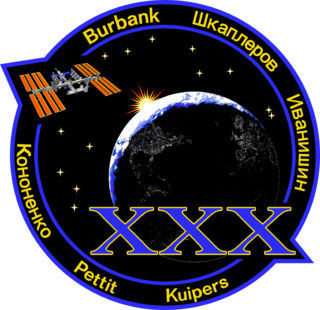
Expedition 30 was the 30th long-duration mission to the International Space Station (ISS). The expedition's first three crew members – Dan Burbank, Anton Shkaplerov and Anatoli Ivanishin – arrived on the ISS aboard Soyuz TMA-22 on 16 November 2011, during the last phase of Expedition 29. Expedition 30 formally began on 21 November 2011, with the departure from the ISS of the Soyuz TMA-02M spacecraft. The expedition ended on 27 April 2012, as Burbank, Shkaplerov and Ivanishin departed from the ISS aboard Soyuz TMA-22, marking the beginning of Expedition 31.

Sergey Nikolayevich Ryazansky is a Russian cosmonaut. He was selected as commander of the IMBP-6 cosmonaut group in 2003, but later transferred to the TsPK Cosmonaut Group. Ryazansky made his first spaceflight aboard the Soyuz TMA-10M/Expedition 37/Expedition 38 mission from September 2013 until March 2014. In 2017, Ryazansky returned to space was the commander of Soyuz MS-05, and served as Flight Engineer for Expedition 52 / 53.

Soyuz TMA-12M was a 2014 flight to the International Space Station. It transported three members of the Expedition 39 crew to the International Space Station. TMA-12M was the 121st flight of a Soyuz spacecraft since the first in 1967 and the 38th Soyuz mission to the ISS.

